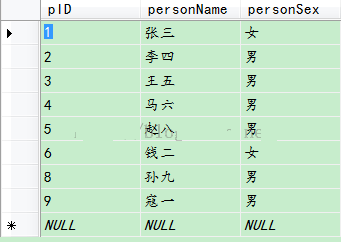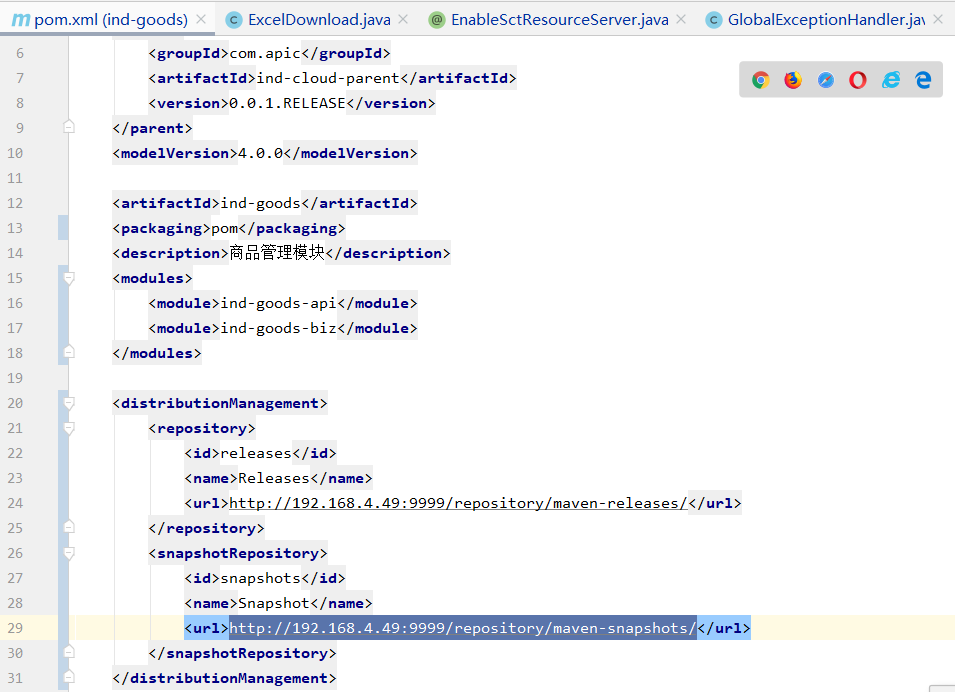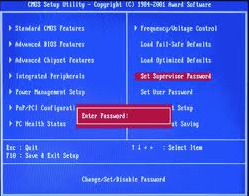前面已经给大家讲解过如何使用Hbase建表,以及基本的操作和一些常用shell命令,今天就给大家介绍下如何使用java对Hbase进行各种操作。
没印象的话可以再去浏览下:
Hbase入门教程,shell命令大全讲解
Java操作Hbase主要方法:
1.Configuration
在使用Java API时,Client端需要知道HBase的配置环境,如存储地址,zookeeper等信息。
这些信息通过Configuration对象来封装,可通过如下代码构建该对象:
Configuration config = HBaseConfiguration.create();
在调用HBaseConfiguration.create()方法时,HBase首先会在classpath下查找hbase-site.xml文件,将里面的信息解析出来封装到Configuration对象中,如果hbase-site.xml文件不存在,则使用默认的hbase-core.xml文件。
2.HBaseAdmin
HBaseAdmin用于创建数据库表格,并管理表格的元数据信息,通过如下方法构建:
HBaseAdmin admin=new HBaseAdmin(config);
3.HTableDescriptor
在HTableDescriptor中,建立了一个表结构,HTableDescriptor封装表格对象,对表格的增删改查操作主要通过它来完成,构造方法如下:
HTableDescriptor table = new HTableDescriptor(TableName.valueOf(“表名”));
4.addFamily
addFamily用于建立表下的列簇,并存放到表结构,方法如下:
HColumnDescriptor base = new HColumnDescriptor(“列簇名”);
table.addFamily(base);
代码如下:
首先建一个maven工程,导入依赖包导pom.xml
|
1
2
3
4
5
6
7
8
9
10
11
12
13
14
15
|
<dependency>
<groupId>org.apache.hbase</groupId>
<artifactId>hbase-client</artifactId>
<version>1.2.0</version>
</dependency>
<dependency>
<groupId>org.apache.hbase</groupId>
<artifactId>hbase-common</artifactId>
<version>1.2.0</version>
</dependency>
<dependency>
<groupId>org.apache.hbase</groupId>
<artifactId>hbase-server</artifactId>
<version>1.2.0</version>
</dependency
|
1、创建表操作
|
1
2
3
4
5
6
7
8
9
10
11
12
13
14
15
16
17
18
19
20
21
22
23
|
public class HBaseClient {
public void createTable() throws IOException {
// 1. 创建配置
Configuration conf = HBaseConfiguration.create();
conf.set("hbase.zookeeper.quorum","ip1");
//hbase主默认端口是60000
conf.set("hbase.master","ip1:60000");
//zookeeper客户端的端口号2181
conf.set("hbase.zookeeper.property.clientPort","2181");
// 2. 创建连接
Connection conn = ConnectionFactory.createConnection(conf);
//3.获得一个建表、删表的对象hbaseAdmin()是继承admin()
Admin admin = conn.getAdmin();
// 4. 创建表的描述信息
HTableDescriptor student = new HTableDescriptor(TableName.valueOf("表名"));
// 5. 添加列簇
student.addFamily(new HColumnDescriptor("列簇名1"));
student.addFamily(new HColumnDescriptor("列簇名2"));
// 6. 调用API进行建表操作
admin.createTable(student);
}
}
|
2、判断表是否存在
|
1
2
3
4
5
6
7
8
9
10
11
12
|
public void isTableExists() throws IOException {
// 1. 创建配置
Configuration conf = HBaseConfiguration.create();
conf.set("hbase.zookeeper.quorum","ip1");
conf.set("hbase.zookeeper.property.clientPort","2181");
// 2. 创建连接
Connection conn = ConnectionFactory.createConnection(conf);
// 3. 创建admin
Admin admin = conn.getAdmin();
// 4. 调用API进行判断表是否存在
System.out.println(admin.tableExists(TableName.valueOf("表名")));
}
|
3、向表中插入数据
|
1
2
3
4
5
6
7
8
9
10
11
12
13
14
15
16
17
18
19
|
public void putData2Table() throws IOException {
// 1. 创建配置
Configuration conf = HBaseConfiguration.create();
conf.set("hbase.zookeeper.quorum","ip1");
conf.set("hbase.zookeeper.property.clientPort","2181");
// 2. 创建连接
Connection conn = ConnectionFactory.createConnection(conf);
// 3. 创建Table类
Table student = conn.getTable(TableName.valueOf("表名"));
// 4. 创建Put类
Put put = new Put(Bytes.toBytes("1001"));
// 5. 向Put中添加 列簇,列名,值 注意:需要转化成字节数组
put.addColumn(Bytes.toBytes("列簇1"),Bytes.toBytes("列1"),Bytes.toBytes("zhangsan"));
put.addColumn(Bytes.toBytes("列簇1"),Bytes.toBytes("列2"),Bytes.toBytes("female"));
put.addColumn(Bytes.toBytes("列簇2"),Bytes.toBytes("列3"),Bytes.toBytes("math"));
put.addColumn(Bytes.toBytes("列簇2"),Bytes.toBytes("列4"),Bytes.toBytes("89"));
// 6.调用API进行插入数据
student.put(put);
}
|
4、查看一条数据
|
1
2
3
4
5
6
7
8
9
10
11
12
13
14
15
16
17
18
19
20
21
22
23
|
public void getDataFromTable() throws IOException {
// 1. 创建配置
Configuration conf = HBaseConfiguration.create();
conf.set("hbase.zookeeper.quorum","ip1");
conf.set("hbase.zookeeper.property.clientPort","2181");
// 2. 创建连接
Connection conn = ConnectionFactory.createConnection(conf);
// 3. 创建Table类
Table student = conn.getTable(TableName.valueOf("表名"));
// 4. 创建 Get 类
Get get = new Get(Bytes.toBytes("1001"));
// 5.调用API进行获取数据
Result result = student.get(get);
// 6. 将返回的结果进行遍历输出
Cell[] cells = result.rawCells();
for (Cell cell : cells) {
System.out.println("rowkey :"+Bytes.toString(CellUtil.cloneRow(cell)));
System.out.println("列簇 :"+Bytes.toString(CellUtil.cloneFamily(cell)));
System.out.println("列名 :"+Bytes.toString(CellUtil.cloneQualifier(cell)));
System.out.println("值 :"+Bytes.toString(CellUtil.cloneValue(cell)));
System.out.println("----------------");
}
}
|
5、删除表操作
|
1
2
3
4
5
6
7
8
9
10
11
12
13
14
15
|
public void dropTable() throws IOException {
// 1. 创建配置
Configuration conf = HBaseConfiguration.create();
conf.set("hbase.zookeeper.quorum","ip1");
conf.set("hbase.zookeeper.property.clientPort","2181");
// 2. 创建连接
Connection conn = ConnectionFactory.createConnection(conf);
// 3. 创建admin
Admin admin = conn.getAdmin();
// 4. 调用API禁用表
admin.disableTable(TableName.valueOf("表名"));
// 5. 调用API删除表
admin.deleteTable(TableName.valueOf("表名"));
}
}
|
6、删除hbase中的table里面的rowkey
|
1
2
3
4
5
6
7
|
public static void deleteRow(String tableName,String rowKey) throws Exception{
HTable hTable = new HTable(configuration,tableName);
Delete delete = new Delete(rowKey.getBytes());
List<Delete> list = new ArrayList<Delete>();
list.add(delete);
hTable.delete(list);
}
|
7、查询row = rowKey的数据
|
1
2
3
4
5
6
7
8
|
public static void getRow(String tableName,String rowKey) throws Exception{
HTable hTable = new HTable(configuration, tableName);
Get get = new Get(rowKey.getBytes());
Result result = hTable.get(get);
for(KeyValue value:result.raw()){
System.out.println("cf:"+new String(value.getFamily())+new String(value.getQualifier())+"="+new String(value.getValue()));
}
}
|
8、查询rowkey在startRow和endRow之间的数据,及rowkey的范围查询
Put、Delete与Get对象都是Row的子类,从该继承关系中我们就可以了解到Get、Delete与Pu对象本身就只能进行单行的操作,
HBase客户端还提供了一套能够进行全表扫描的API,方便用户能够快速对整张表进行扫描,以获取想要的结果—scan:
|
1
2
3
4
5
6
7
8
9
10
11
12
13
14
15
16
17
18
|
public static void getBetweenRow(String tableName,String startRow,String stopRow) throws Exception{
HTable table = new HTable(configuration, tableName);
Scan scan = new Scan();
scan.addColumn("cf1".getBytes(), "colum1".getBytes());
scan.addColumn("cf1".getBytes(), "colum2".getBytes());
scan.addColumn("cf1".getBytes(), "colum3".getBytes());
scan.setStartRow(startRow.getBytes());
scan.setStopRow(stopRow.getBytes());
ResultScanner scanner = table.getScanner(scan);
for(Result result:scanner){
for(KeyValue value:result.raw()){
System.out.println("cf:"+new String(value.getFamily())+new String(value.getQualifier())+"="+new String(value.getValue()));
}
}
}
|
9、批量写入
|
1
2
3
4
5
6
7
8
9
10
11
12
13
14
15
16
17
18
19
20
21
22
23
24
25
26
27
28
29
30
31
32
33
34
35
36
37
38
39
40
41
42
43
44
45
46
47
48
49
50
51
52
53
54
55
|
public <T> void puts(String tableName, Map<String, Object> items) {
if (items == null || items.isEmpty()) {
LOG.error("[HBase] Adding null/empty item map!");
return;
}
int maxSize = 10000;
Table table = null;
try {
table = con.getTable(TableName.valueOf(tableName));
int eachSize = Math.min(maxSize, items.size());
List<Put> puts = new ArrayList<Put>(eachSize);
int handled = 0;
for (Entry<String, Object> entry : items.entrySet()) {
String ultimateRowKey = getHashedID(entry.getKey());
Object value = entry.getValue();
if (ultimateRowKey == null || ultimateRowKey.isEmpty()) {
LOG.error("[HBase] Adding null/empty hashed key! Original key is " + entry.getKey());
handled++;
continue;
}
Put put = new Put(Bytes.toBytes(ultimateRowKey));
put.addColumn(Bytes.toBytes(familyName1), Bytes.toBytes("ab"), Bytes.toBytes(value .getAb()));
put.addColumn(Bytes.toBytes(familyName1), Bytes.toBytes("dt"), Bytes.toBytes(value .getDt()));
put.addColumn(Bytes.toBytes(familyName1), Bytes.toBytes("hb"), Bytes.toBytes(value .getHb()));
Gson gson = new Gson();
String valuestr = gson.toJson(value);
put.addColumn(Bytes.toBytes(familyName2), Bytes.toBytes("js"), Bytes.toBytes(valuestr));
puts.add(put);
handled++;
// 每隔10000,写一次
if (handled == eachSize) {
LOG.info("[HBase] Adding " + eachSize + "rows!");
table.put(puts);
puts = new ArrayList<Put>(eachSize);
}
}
if (puts.size() > 0)
table.put(puts);
} catch (IOException e) {
LOG.error("[HBase] Error while putting data " + e.getMessage());
} finally {
try {
if (table != null)
table.close();
} catch (IOException e) {
LOG.error("[HBase] Error while closing table " + e.getMessage());
}
}
}
|
到此这篇关于使用Java对Hbase操作总结及示例代码的文章就介绍到这了,更多相关Java操作hbase总结内容请搜索快网idc以前的文章或继续浏览下面的相关文章希望大家以后多多支持快网idc!
原文链接:https://blog.csdn.net/zp17834994071/article/details/107501922
相关文章
- 个人服务器网站搭建:如何选择合适的服务器提供商? 2025-06-10
- ASP.NET自助建站系统中如何实现多语言支持? 2025-06-10
- 64M VPS建站:如何选择最适合的网站建设平台? 2025-06-10
- ASP.NET本地开发时常见的配置错误及解决方法? 2025-06-10
- ASP.NET自助建站系统的数据库备份与恢复操作指南 2025-06-10
- 2025-07-10 怎样使用阿里云的安全工具进行服务器漏洞扫描和修复?
- 2025-07-10 怎样使用命令行工具优化Linux云服务器的Ping性能?
- 2025-07-10 怎样使用Xshell连接华为云服务器,实现高效远程管理?
- 2025-07-10 怎样利用云服务器D盘搭建稳定、高效的网站托管环境?
- 2025-07-10 怎样使用阿里云的安全组功能来增强服务器防火墙的安全性?
快网idc优惠网
QQ交流群
-
2025-05-27 52
-
2025-05-29 65
-
2025-05-29 26
-
2025-05-29 30
-
2025-05-29 108











